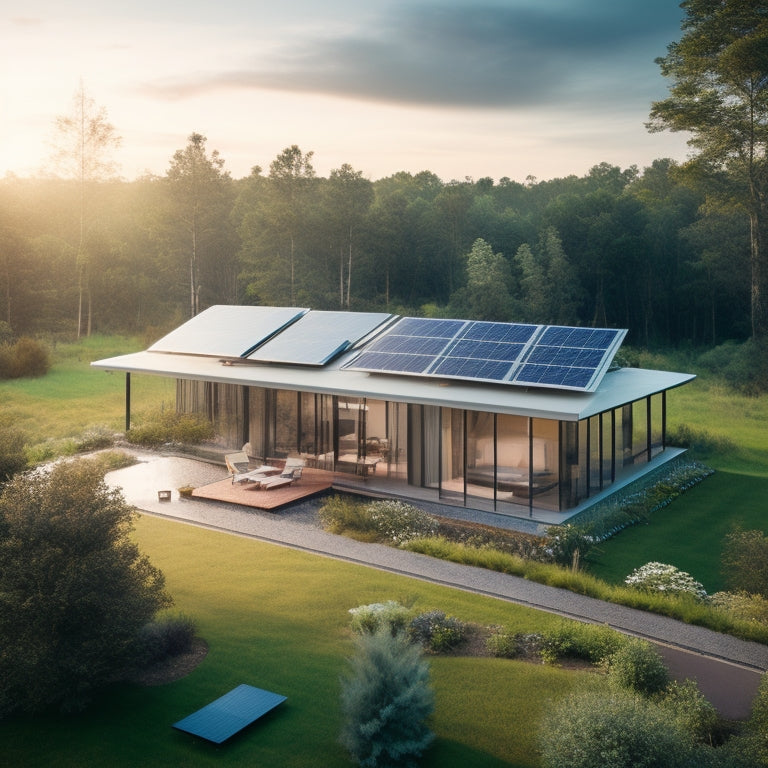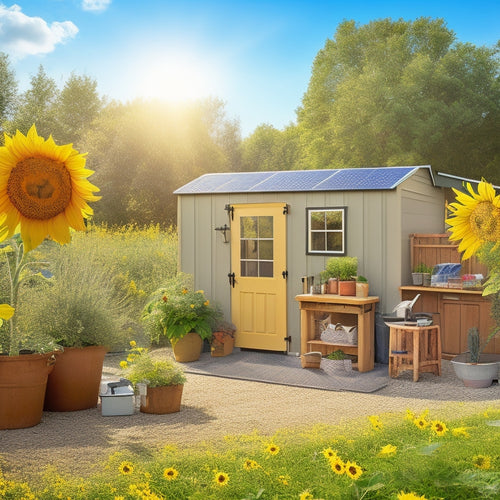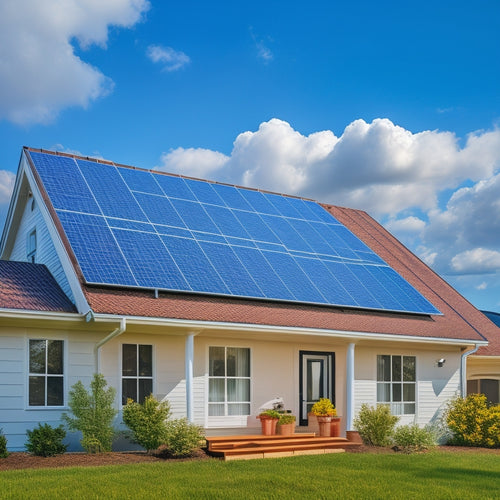
What Homeowners Need to Go Off the Grid
Share
To go off the grid, you'll need to evaluate your daily power usage, seasonal variations, and appliance ratings to determine your ideal system configuration. This includes examining your energy needs, choosing the right equipment like solar panels and battery systems, and designing a system customized to your requirements. You'll also need to take into account installation and maintenance tasks, such as cleaning solar panels and checking battery levels. Finally, you'll need to budget for upfront costs, ongoing expenses, and investigate renewable incentives. By carefully reflecting on these factors, you'll be well on your way to achieving energy independence - and there's more to uncover in the world of off-grid living.
Key Takeaways
- Assess daily energy needs and seasonal variations to determine the right system size for off-grid energy independence.
- Choose the right equipment, including solar panels, batteries, inverters, and mounting hardware, based on specific needs and budget.
- Design a system that considers optimal solar panel placement, shading, orientation, and roof size for maximum energy harvesting.
- Ensure proper installation, maintenance, and inspections to maximize energy harvesting and safety, and extend system lifespan.
- Create a realistic budget that incorporates upfront costs, ongoing expenses, and renewable incentives to achieve energy independence.
Assessing Your Energy Needs
As you consider breaking free from the grid, accurately evaluating your energy needs becomes an important step in determining the feasibility of off-grid living.
You'll need to assess your energy consumption patterns, including your daily power usage, seasonal variations, and peak demand periods. To achieve this, it's vital to calculate daily energy requirements considering appliance power ratings, usage patterns, and operational hours.
This will help you identify areas where you can make lifestyle adjustments to reduce your energy consumption. For instance, you might consider replacing incandescent bulbs with LEDs, upgrading to energy-efficient appliances, or implementing passive heating and cooling strategies.
Choosing the Right Equipment
Freedom from the grid hinges on selecting the right equipment, a crucial decision that can make or break your off-grid venture.
You'll need to choose from various solar panel types, each with its own efficiency and cost considerations. Monocrystalline panels offer high efficiency but come at a higher cost, while polycrystalline panels provide a more affordable option with slightly lower efficiency.
When it comes to battery charging, look for systems with advanced features like MPPT and multi-stage charging for efficiency and superior energy harvesting.
Additionally, you'll need to ascertain your battery storage options. Lead-acid batteries are a cost-effective choice, but lithium-ion batteries provide longer lifetimes and deeper discharge capabilities.
You'll also need to evaluate inverters, charge controllers, and mounting hardware to complete your off-grid system.
With so many options available, it's crucial to research and compare products to find the best fit for your specific needs and budget.
Designing Your Off-Grid System
Having selected the right equipment, you're now ready to design your off-grid system. This involves determining the best solar panel placement on your roof or in your yard to maximize energy harvesting.
Consider factors like shading, orientation, and roof size to guarantee your solar array operates at peak efficiency. For top performance, it's crucial to choose high-efficiency solar panels with certifications from UL or IEC, as they provide durability and consistent power output quality solar panels.
Next, evaluate battery storage options to guarantee a reliable and efficient energy supply. You'll need to decide on the type and number of batteries, as well as the charging and discharging protocols.
Proper system design is critical to achieving energy independence, so take your time and consider consulting with an expert if needed. A well-designed system will provide you with a reliable source of energy for years to come.
Installing and Maintaining Systems
Your off-grid system is only as good as its installation, so it is vital to get it right. A well-planned solar panel installation can guarantee maximum energy harvesting, while a poorly installed system can lead to reduced efficiency and even safety hazards. When it comes to battery maintenance, regular checks are essential to extend their lifespan and prevent unexpected power outages.
| System Component | Maintenance Task |
|---|---|
| Solar Panels | Clean panels every 6 months to guarantee optimal energy absorption |
| Batteries | Check electrolyte levels and charge/discharge cycles monthly |
| Inverters | Perform firmware updates and inspect for signs of wear quarterly |
| Charge Controllers | Monitor temperature and voltage settings bi-monthly |
| Mounting Structures | Inspect for signs of corrosion or damage annually |
Budgeting for Energy Freedom
As you've guaranteed your off-grid system is running smoothly, it's time to turn your attention to the financial aspects of achieving energy independence.
Budgeting for energy freedom requires careful financial planning to guarantee a seamless shift. You'll need to evaluate the upfront costs of your system, including equipment and installation, as well as ongoing expenses like maintenance and replacement parts.
Fortunately, there are renewable incentives available to help offset these costs, such as tax credits and rebates. By factoring these incentives into your financial planning, you can create a realistic budget that allows you to achieve energy independence without breaking the bank.
With a solid financial plan in place, you'll be well on your way to enjoying the benefits of off-grid living.
Frequently Asked Questions
Can I Still Use My Existing Appliances off the Grid?
You can use some existing appliances off the grid, but you'll need to assess their energy efficiency; many modern appliances are designed for grid-tied systems, so you may need to replace or modify them to optimize performance off-grid.
Will I Need to Change My Lifestyle to Go off the Grid?
Are you ready to rethink your daily habits? To go off the grid, you'll need to adopt sustainable practices and excel in resource management, making conscious choices about energy and water usage to minimize your ecological footprint.
How Do I Handle Energy Storage During Extended Periods of Low Sunlight?
When dealing with extended low-sunlight periods, you'll need to prioritize battery maintenance, ensuring your storage system is fully charged before the downturn. Consider investing in solar alternatives like wind or hydro power to supplement your energy needs during this time.
Are Off-Grid Homes More Prone to Electrical Fires or Safety Issues?
Don't you wonder if off-grid homes are ticking time bombs? Actually, they're not, as long as you prioritize fire prevention and implement safety measures like surge protectors, grounding systems, and regular electrical inspections to mitigate risks.
How Does Going off the Grid Affect My Property's Resale Value?
When you go off the grid, you'll impact your property's resale value; a professional property appraisal will assess your home's unique features, influencing the resale market, and you'll need to weigh the benefits of energy independence against potential buyers' concerns.
Related Posts
-

How to Achieve a Zero-Waste Lifestyle for a Greener Tomorrow
To achieve a zero-waste lifestyle, start by adopting the principles of refusing, reducing, reusing, and recycling. Sw...
-

Building an Emergency Backup Solar Power System in 5 Essential Steps
Building an emergency backup solar power system involves five key steps. First, assess your daily energy needs to ide...
-

Cost of Solar Panel Installation
You can expect to pay between $15,000 and $30,000 or more for a typical solar panel installation, depending on the sy...


